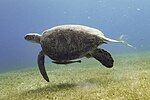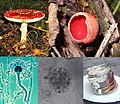the insects turned up by grazing mammals. The word "commensalism" is derived from the word "commensal", meaning "eating at the same table" in human social...
28 KB (3,006 words) - 04:00, 29 January 2025
Community (ecology) (section Commensalism)
type of commensalism is called inquilinism, the orchid permanently lives on the tree. Phoresy is another type of commensalism, the commensal uses the...
46 KB (5,380 words) - 15:01, 31 December 2024
Symbiosis (section Commensalism)
from parasitism or commensalism, Fungi's relationship to plants in the form of mycelium evolved from parasitism and commensalism. Under certain conditions...
52 KB (5,606 words) - 13:49, 9 January 2025
Usually, the mites do not cause any harm, so are considered an example of commensalism rather than parasitism; but they can cause disease, known as demodicosis...
12 KB (1,303 words) - 03:25, 5 December 2024
Ureaplasma parvum (section Commensalism)
urealyticum biovar 1. Ureaplasma parvum has been identified as being a commensal in the female reproductive tract as part of the microbiome in healthy...
11 KB (1,262 words) - 11:36, 19 July 2024
Ectosymbiosis (section Commensalism)
sessile) organism existing off of biotic substrate through mutualism, commensalism, or parasitism. Ectosymbiosis is found throughout a diverse array of...
14 KB (1,581 words) - 14:12, 15 October 2024
Biological interaction (section Commensalism)
main parent plant. The six possible types of symbiosis are mutualism, commensalism, parasitism, neutralism, amensalism, and competition. These are distinguished...
30 KB (3,232 words) - 08:19, 23 January 2025
Hoplophrys (redirect from Commensal soft coral crab)
Hoplophrys oatesii, also known as the candy crab, Oates's soft coral crab, commensal soft coral crab and Dendronephthya crab. Hoplophrys oatesii is a very...
3 KB (286 words) - 23:15, 3 October 2024
Bacteria (section Commensals)
divided into parasitism, mutualism and commensalism. The word "commensalism" is derived from the word "commensal", meaning "eating at the same table" and...
146 KB (15,857 words) - 21:04, 27 January 2025
infests honey bee nests, while many species are parasitic inquilines or commensal in the nests of ants. A few groups of beetles are primary parasitoids...
155 KB (16,995 words) - 02:41, 30 December 2024
important basidiomycetes include the maize pathogen Ustilago maydis, human commensal species of the genus Malassezia, and the opportunistic human pathogen...
203 KB (19,384 words) - 17:18, 13 January 2025
Synoeca septentrionalis is one of five species of wasps in the genus Synoeca. It is a swarm-founding wasp that is also eusocial, exhibiting complicated...
17 KB (2,254 words) - 05:46, 4 January 2025
Umbrella species Species interaction Antibiosis Biological interaction Commensalism Community ecology Ecological facilitation Interspecific competition Mutualism...
109 KB (11,601 words) - 09:33, 16 January 2025
the late prehistoric dispersal of Polynesians to New Zealand using the commensal Pacific rat". Proceedings of the National Academy of Sciences of the United...
266 KB (22,018 words) - 09:38, 1 February 2025
flora indefinitely. Adventive plant Archaeophyte Assisted migration Commensalism Domestication Ecosystem management Environmental impact of agriculture...
6 KB (586 words) - 17:56, 6 January 2025
ISBN 1-86872-713-0. TOKESHI, MUTSUNORI (June 1993). "On the evolution of commensalism in the Chironomidae". Freshwater Biology. 29 (3): 481–489. Bibcode:1993FrBio...
9 KB (885 words) - 11:39, 10 September 2024
Microbial ecology (section Commensalism)
partner is harmed. Some symbiotic relationships include mutualism and commensalism. Certain substances in the environment can kill microorganisms, thus...
56 KB (5,903 words) - 21:17, 21 January 2025
Eunoe pallida (section Commensalism)
thicker than neurochaetae. Bidentate neurochaetae absent. E. pallida is commensal; its host taxa are sea stars and possibly sea cucumbers. Read, G.; Fauchald...
2 KB (193 words) - 08:39, 27 February 2021
Archaea (section Commensalism)
pathogens or parasites are known. Instead they are often mutualists or commensals, such as the methanogens (methane-producing strains) that inhabit the...
154 KB (16,775 words) - 16:22, 30 January 2025
Sea cucumber (section Symbiosis and commensalism)
the regular tube feet. Numerous small animals can live in symbiosis or commensalism with sea cucumbers, as well as some parasites. Some cleaner shrimps can...
60 KB (6,701 words) - 04:24, 15 January 2025
Plant–animal interaction (section Commensalism)
Plant parasites are a common term for sap-sucking insects like aphids. Commensalism is the term used to describe a situation in which one organism gains...
14 KB (1,544 words) - 07:20, 22 June 2024
in distant polar regions of the planet. This relationship is called commensalism because many others receive the benefits of clean air at no cost or harm...
210 KB (21,517 words) - 22:51, 19 January 2025
Porpita porpita (section Commensalism with a fish)
Porpita porpita, or the blue button, is a marine organism consisting of a colony of hydroids found in the warmer, tropical and sub-tropical waters of the...
11 KB (1,122 words) - 00:11, 29 January 2025
Plant ecology (section Commensalism)
where competition may be the most important interaction among species. Commensalism is similar to facilitation, in that one plant is mostly exploiting another...
39 KB (3,768 words) - 02:03, 17 June 2024
American wolves. The dog is a domestic animal that likely travelled a commensal pathway into domestication (i.e. humans initially neither benefitted nor...
187 KB (17,587 words) - 01:02, 30 January 2025
Hydractinia altispina (redirect from High-spined commensal hydroid)
altispina, or high-spined commensal hydroid, is a small colonial hydroid in the family Hydractiniidae. High-spined commensal hydroids grow as a fuzzy-looking...
1 KB (142 words) - 16:39, 30 September 2021
Idia gopheri (redirect from Tortoise Commensal Noctuid Moth)
Idia gopheri, the tortoise commensal noctuid moth, is a litter moth in the family Erebidae. The species was first described by J. B. Smith in 1899. Idea...
1 KB (101 words) - 20:59, 9 May 2023
Host (biology) (section Commensal hosts)
host. In parasitism, the parasite benefits at the host's expense. In commensalism, the two live together without harming each other, while in mutualism...
27 KB (2,862 words) - 02:38, 15 January 2025
Insect ecology (section Commensalism)
species within their community and these interaction include mutualism, commensalism, ammensalism, parasitism and neutralisms. Insects play significant roles...
49 KB (5,944 words) - 01:07, 15 January 2025
Váchová, Hana; Volfová, Radka; Munclinger, Pavel (2005). "Aggression and commensalism in house mouse: A comparative study across Europe and the near east"...
66 KB (7,660 words) - 16:28, 4 January 2025


























